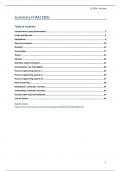Summary
Summary Food Fermentation (FHM21806)
- Course
- Institution
This summary was written in this academic year. It contains all lecture notes from this course, combined with the provided literature, quiz answers (incorporated in the text) and information from the preceding course Food Microbiology (FHM20306). Topics covered in the summary: - Notes from all ...
[Show more]



